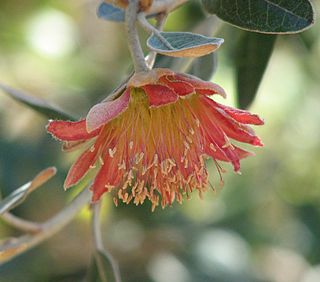
Diplolaena grandiflora, commonly known as wild rose or Tamala rose, is a shrub which is endemic to Western Australia.

Corymbia gummifera, commonly known as red bloodwood, is a species of tree, rarely a mallee, that is endemic to eastern Australia. It has rough, tessellated bark on the trunk and branches, lance-shaped adult leaves, flower buds in groups of seven, creamy white flowers and urn-shaped fruit.
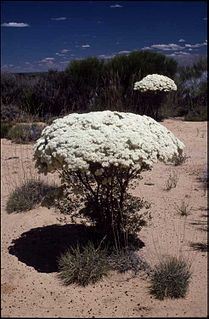
Verticordia brownii, commonly known as pink brownii or pink cauliflower is a flowering plant in the myrtle family, Myrtaceae and is endemic to the south-west of Western Australia. It has small, neatly arranged, oval leaves and heads of pale pink to magenta or white flowers. It was one of the first verticordias to be collected, although it was not initially known by that name. The collection was made by Robert Brown on the Bass and Flinders circumnavigation of the Australian mainland on HMS Investigator.

Verticordia plumosa, commonly known as plumed featherflower, is a flowering plant in the myrtle family, Myrtaceae and is endemic to the south-west of Western Australia. It was the first species in the genus to be described, although initially given the name Chamelaucium plumosum. It is a shrub with linear leaves and rounded groups of scented pink, mauve or white flowers. Two varieties of this species have been declared as being "threatened".
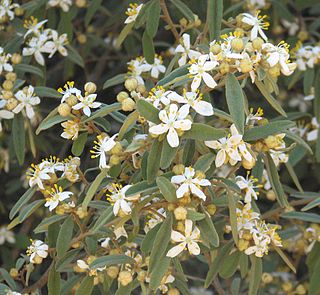
Asterolasia hexapetala is a species of erect, spreading shrub that is endemic to the Warrumbungles in New South Wales. It has oblong to elliptical leaves with star-shaped hairs, especially on the lower surface, and white flowers arranged in small groups in leaf axils and on the ends of branchlets, the back of the petals densely covered with white, yellow or brown, woolly star-shaped hairs.

Ricinocarpos pinifolius, commonly known as wedding bush, is a shrub of the family Euphorbiaceae and is endemic to eastern Australia. It has fragrant daisy-like flowers in spring.

Leucospermum praemorsum is an evergreen shrub or small tree of up to 5 m (16 ft) high. It has hairless oblong to inverted lance-shaped leaves of 7–8 cm long and 1½–2 cm wide, tapering at their base to a stalk of up to 2 cm long, and cut-off at the tip with three to five teeth, and pale carmine, inverted cone-shaped flower heads. From the center of the flowers emerge long initially orange, later deep crimson styles that jointly give the impression of a pincushion. It is called Nardouw fountain-pincushion or Nardouw pincushion in English and Nardouwluisiesbos in Afrikaans. Flower heads can be found off and on throughout the year, particularly in older plants, with a peak between July and December. It is an endemic species that can only be found in part of the Western Cape province of South Africa.

Leucospermum grandiflorum is an evergreen, upright shrub of up to 2½ m high that is assigned to the family Proteaceae. It has elliptic, greyish green, softly hairy leaves and initially egg-shaped heads with yellow flowers, later flatter with flowers turning orange. From the center of each flower emerges a long pale yellow style with a pink thickened tip that is bent slightly clockwise, giving the entire head the appearance of a pincushion. Its flowers can be found between July and December. It is called grey-leaf fountain-pincushion or rainbow pincushion in English. L. grandiflorum is an endemic species that can only be found in nature in the Western Cape province of South Africa.
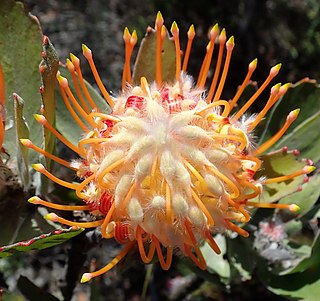
Leucospermum pluridens is a large upright evergreen shrub of up to 3 m (10 ft) high assigned to the family Proteaceae. It has leathery, oblong to wedge-shaped leaves of about 7½ cm long and 2½ cm wide, deeply incised near the tip with seven to ten teeth. It has initially yellow, later carmine coloured flower heads. The 2 cm long bracts have slender, recurved tips. From the center of the perianth emerge long styles that jointly give the impression of a pincushion. It is called Robinson pincushion in English and Robinson-kreupelhout in Afrikaans. Flowers can be found between September and December. It naturally occurs in the south of South Africa.
Leucospermum fulgens is an evergreen, upright shrub of up to 3 m (10 ft) high, from the family Proteaceae. It has hairless and leathery inverted lance-shaped to oblong leaves tipped with mostly three teeth and globe- to egg-shaped flowerheads of 6–8 cm in diameter, that consist of pink to orange, later crimson flowers. From the center of the flowers emerge almost straight styles that jointly give the impression of a pincushion. It is called Potberg pincushion in English. New pink to orange flower heads occur between August and November, but older, crimson heads may persist until January. It is a critically endangered species, only known from one location in the Western Cape province of South Africa.

Vexatorella amoena, also known as the Swartruggens vexator is an evergreen shrub of up to about 1 m (3 ft) high, that is assigned to the family Proteaceae. It has entire, inverted egg-shaped, bluish grey, leathery leaves of 1½–3 cm (0.6–1.2 in) long and 5–11 mm (0.20–0.45 in) wide on a distinct stalk, and globular flower heads of about 2 cm (0.8 in) across with pale pink flowers with extended, thick-tipped styles at the tip of the branches. The plants are flowering from September to November. It is an endemic species that is restricted to the Western Cape province of South Africa.
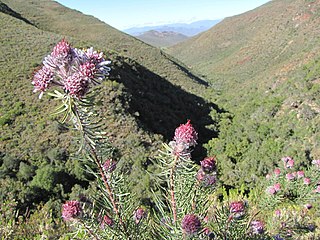
Vexatorella latebrosa, also known as the Robertson vexator, is an evergreen, upright shrub of up to about 1½ m high, from the family Proteaceae. It has entire, long inverted egg-shaped, bluish grey, leathery leaves that are line-shaped to very narrowly spade-shaped in outline, 5–6½ cm (2.0–2.6 in) long and 2–3 mm (0.08–0.12 in), and mostly solitary globular flower heads at the end of the branches of 2½–3 cm (0.8 in) across with scented, pink to carmine flowers with extended, styles with a thickened tip. The plants are flowering from August to September. It is an endemic species that is restricted to the Western Cape province of South Africa.

Mimetes saxatilis or limestone pagoda is an evergreen, upright, rarely branching shrub of 1–2¼ m high, assigned to the family Proteaceae. The approximately oval leaves are 3½–5 cm (1.4–2.0 in) long and 1½–3 cm (0.6–1.2 in) wide with a blunt, thickened, reddish tip or with three crowded teeth. It has cylinder-shaped inflorescences topped by a crest of green leaves, further consisting of heads with 12-22 individual bright yellow flowers, each in the axil of a flat, green leaf. It is an endemic species that is restricted to limestone outcrops in the Agulhas plains in the very south of the Western Cape province of South Africa. It is considered an endangered species. Flowering may occur between July and December, but is unreliable in its timing, dependent on sufficient moisture availability.

Mairia coriacea is a perennial plant assigned to the daisy family. It has broad, tough and leathery, evergreen leaves. These have a narrowed foot and an entire margin or a few shallow, irregular teeth. They grow in a rosette directly from the rootstock. The plant produces flower heads with one whorl of white to mauve ray florets around many yellow disc florets, with one or few on top of a dark reddish, woolly stalk. Flower heads appear after the overhead vegetation burnt down, often destroying the leaves in the process. It can be found in the southern mountains of South Africa's Western Cape province. It is called leather leaves in English.
Leionema oldfieldii is a small shrub that is endemic to mountainous locations in Tasmania, Australia. It has dark green leaves, compact pale pink to white flowers from November to January.

Rhadinothamnus euphemiae, is a slender, small, upright shrub with needle-shaped branchlets thickly covered with silvery scales and tubular greenish-purple tubular flowers throughout the year. It is endemic to the south coast of Western Australia.
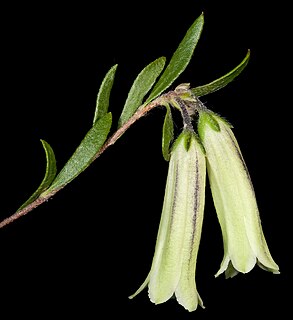
Muiriantha is a genus of plant containing the single species Muiriantha hassellii and is endemic to the south coast of Western Australia. It is a small shrub with branchlets covered sparsely in hairs, leathery leaves and yellowish-green pendulous flowers.
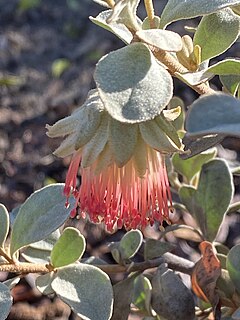
Diplolaena mollis, is a species of flowering plant in the family Rutaceae and is endemic to the west coast of Western Australia. It has broadly elliptic or egg-shaped, leathery leaves that are densely covered in hairs and reddish, pendulous flowers.

Diplolaena andrewsii, is a species of flowering plant in the family Rutaceae and is endemic to the west coast of Western Australia.
Diplolaena cinerea, is a species of flowering plant in the family Rutaceae and is endemic to the west coast of Western Australia. It has pale orange flowers, papery, elliptic shaped leaves that are covered in star-shaped hairs on the upper surface.

















